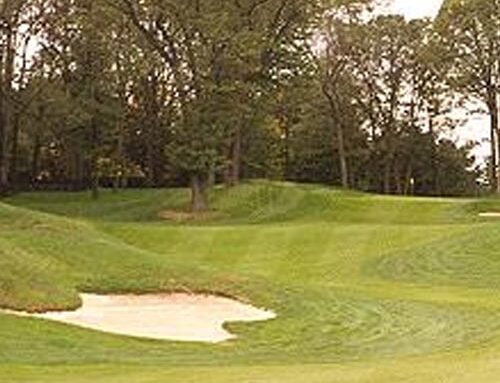Cape Breton Highlands Links
Nova Scotia, Canada

Cape Breton’s incomparable setting coupled with Stanley Thompson’s talents combine to make Highlands Links one of the most distinctive courses in world golf.
Thanks in part tothe success of the courses that opened in the late 1920s within the national parks of Jasper and Banff in Alberta, the National Park Services of Canada decided in 1938 to pursue a work program to create jobs and stimulate tourism interest by building a golf course in Cape Breton Highlands National Park.
Occupying the northern portion of the 4,000 square mile Cape Breton Island with the Atlantic on one side and the Gulf of St. Lawrence on the other, Cape Breton Highlands Park is blessed with every physical attribute imaginable, from beaches to river valleys to mountains. While there was already much to do including salmon fishing, hiking and whale watching, The Canadian Park Service wanted to give people an additional reason to venture to this beautiful part of the world. Thus, they hired Stanley Thompson to work his magic and build another world class golf course to act as a draw.
Work commenced in 1939 with Geoffrey Cornish as construction supervisor. Closely paralleling the construction of the golf course, The Keltic Lodge was built to provide adjacent first rate lodgings.
As many as 200 people were employed constructing Highlands Links at any given time and the course took two years to complete. Stanley Thompson‘s routing is a marvel as the variety of settings without loss of continuity or character is unique in all of golf. The first six holes play near but never touch the shoreline; the player then crosses the Cabot Trail and enters the deep woods and hills for the 7th – 9thwith the one shot 10thdropping him down into a river valley for the 11th and 12th holes.After a480 yard stroll from the 12th green along the river to the 13th tee, the Atlantic Ocean comes into view again. The 14th plays back inland with a mountain as a backdrop, the 15th straight back to the Atlantic Ocean with Whale Island in the distance. And finally, the last three holes, back near the shoreline, are a roller coaster ride across thrilling topography to the clubhouse.
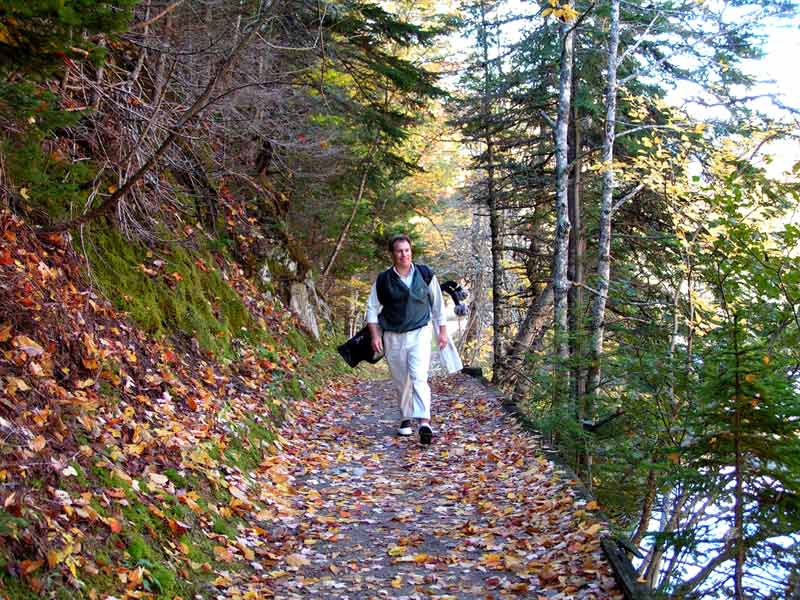
The walk from the 12th green to the 13th tee along the Clyburn Brook is so tranquil that it hardly matters that the green to tee distance is 480 yards.
The blend of holes is altogether unique. For those golfers who like the randomness of links golf and properly flighting the ball in the wind from an awkward stance, the early and late holes are as good as it gets. Conversely, the golfer who prefers mountain golf takes delight in the middle stretch of holes with their stunning backdrops. To the best of the author’s knowledge, no other course in the world so successfully combines these two generally disparate forms of golf into one harmonious course.
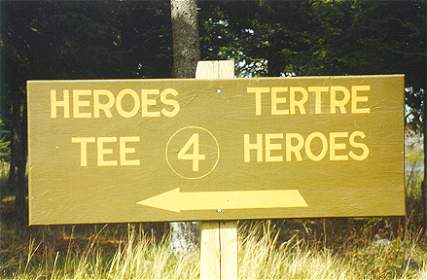
A reminder that you are in the Canadian Maritimes.
Holes to Note
First hole, 405 yards, Ben Franey; If there is such a thing as a prevailing wind, it is into the golfer on the first six holes. Thus, with both the tee ball and approach shot uphill,the 1stgreenis often an elusive target. When asked which hole has given him the most fits in relation to par during his first (!)35 years as Head Professional, Joe Robinson suggested that it may well be the 1st. Highlighting that claim is George Knudson’s2 iron approach under the wind in the Shell’s Wonderful World of Golf match versus fellow Canadian touring professional Al Balding in 1964. Perfectly struck, Knudson’s approach came up 10 yards shy of the putting surface.

The golfer is immediately introduced in the 1st fairway to one of Cape Breton’s challenges: finding a level stance.
Second hole, 445 yards, Tam O’Shanter; As the 1st plays uphill, the 2nd tumbles downhill with 110 feet of elevation change from tee to green. Similar with the 1st fairway, the 2nd fairway is littered with humps and bumps normally associated with the links courses in the U.K. In this case, the humps and bumps were created by man. According to Geoffrey Cornish, as the construction crew was clearing the property, Stanley Thompson instructed them precisely were to place stone and rocks in small piles. Stanley Thompson covered these piles with soil from the river silt and these random piles became an integral part of how the1st, 2nd, 14th, and 16th holes play. Of those four holes,the 2nd, 14th and 16thare bunkerless,with theground contours providing ample challenge. Too few modern architects show restraint in bunkering with only a couple of examples readily coming to mind such as Coore& Crenshaw’s 13th hole at Cuscowilla and Gil Hanse’s 9th holeat Rustic Canyon.
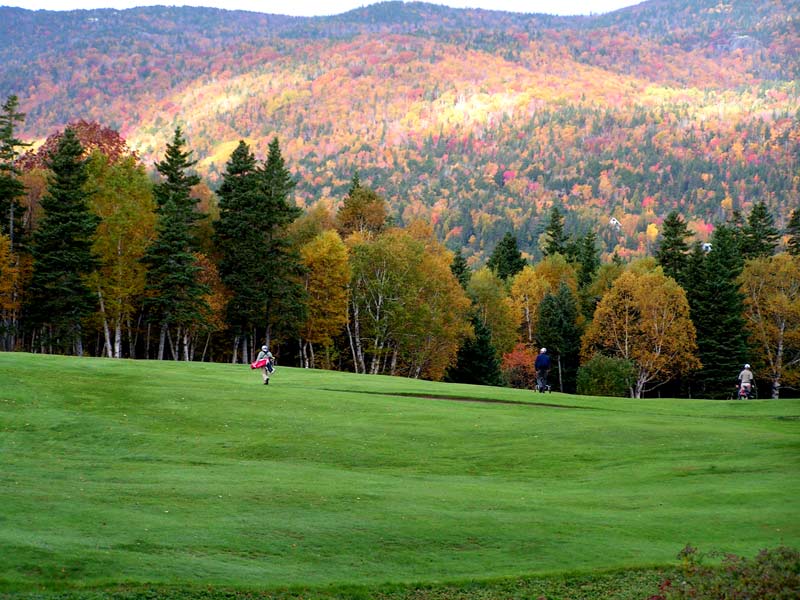
The ideal drive at the 2nd carries the crest and then tumbles downhill, leaving the golfer…
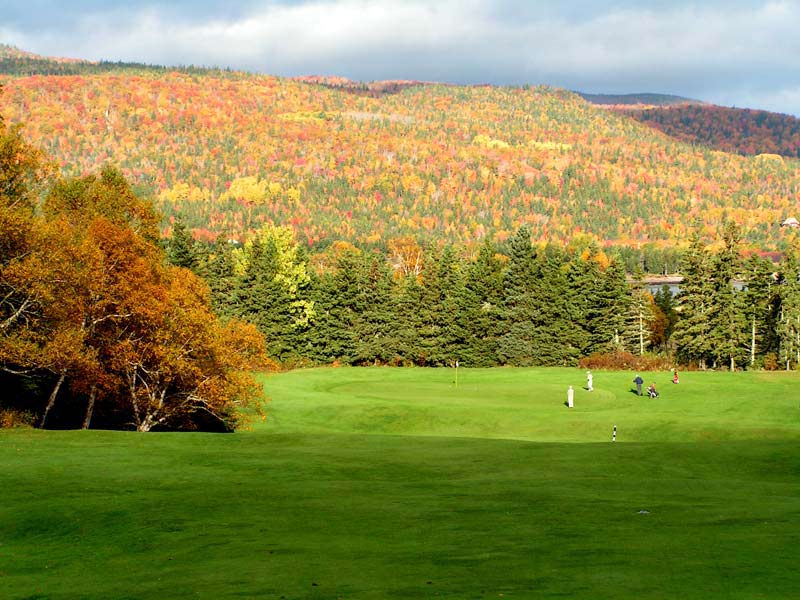
…with a long downhill approach shot from a sloping stance. A supremely natural hole, man’s hand is hardly evident in its creation.
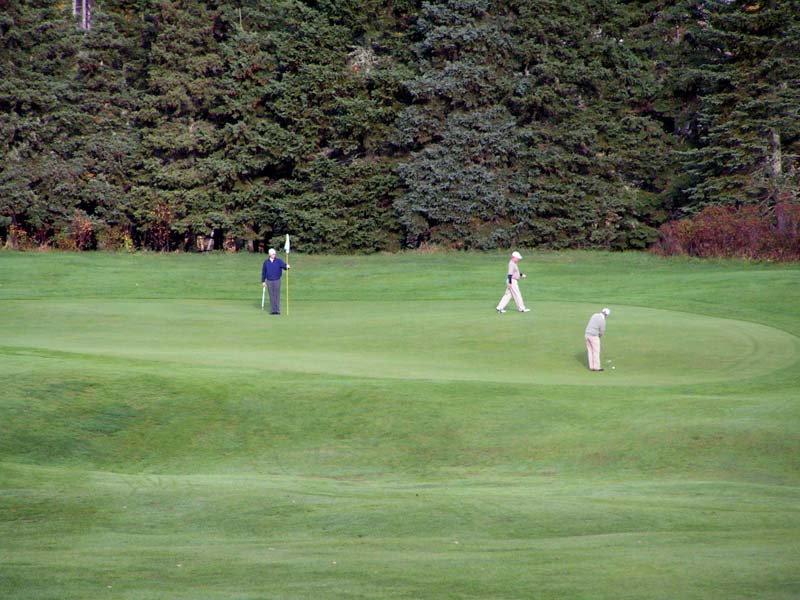
Look at the feet of the three golfers to understand the wild interior contours of the 2nd green. Thompson named the hole Tam O’Shanter as the green’s shape reminded him of a Scot’s hat.
Third hole, 160 yards, Lochan; The idyllic 3rd plays over the corner of a lake that was created by a barriochise. The green is well back from the water and the principal challenge is in placing the ball on the correct side of a hogback that crosses the green on a 1 o’clock to6 o’clock axis. Three putting becomes a real issue when one finds his ball and the hole on opposite sides of the hogback.
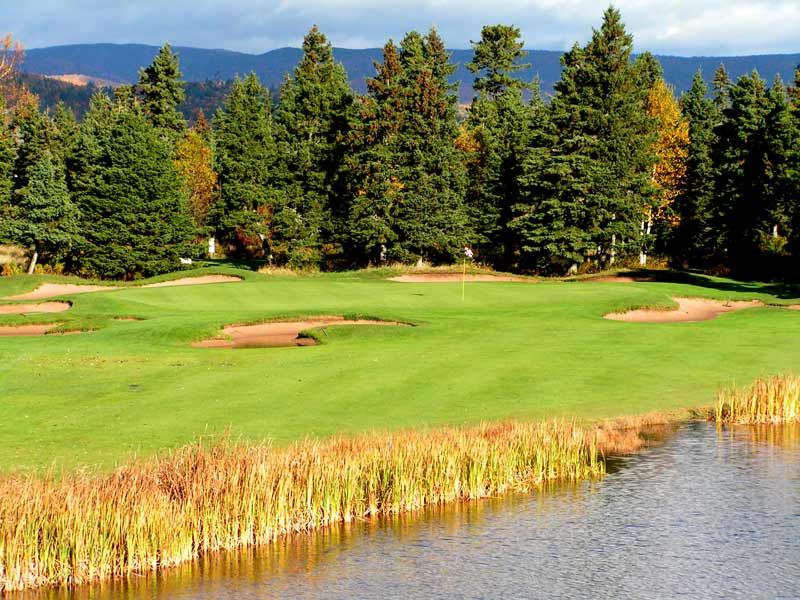
The merits of playing golf in such a beautiful environment as Cape Breton can not be overstated. The hogback that divides the green is just to the left of the flag, making the effective target not nearly as big as one might first think.
Fourth hole, 325 yards, Heich O’Fash; Given the rigors of the 1st and 2nd hole, and given the comforting appearance of the 3rd, the golfer may take one look at the yardage on this hole and relax. What a mistake (!) and Joe Robinson has seen more 8s on this hole from good players than any other hole on the course.Indeed, its name Heich O’Fash means heap of trouble. Such short two shotters are an absolute must for any great course with the absence of such a hole the obvious short coming of the Black Course at Bethpage. Along with other greats such as Cypress Point, Pine Valley and The Old Course at St. Andrews, Highlands Links possesses several excellent holes under 350 yards in length, starting here at the 4th. The original Thompson tee is to the left of the 3rd green but was abandoned due to its proximity to a pull hook from the 3rd tee. From the original tee, the hole played dead straight to the green 295 yards away. The new tee behind the 3rd green adds a left to right bend to the hole and 25 yards in length making the green no longer drivable. Thus, the good golfer is less tempted to be greedy, which is a shame as that’s when the fireworks can occur. Regardless, the green complex atop a knob highlights Thompson’s genius for routing a course. While an appealing sandy arealies30-40 yards to the right of the fairway, the most interesting land form is the knob, and thus Thompson followed nature’s lead in placing the hole here.

Any approach shot that doesn’t find the putting surface is likely to be shrugged well away from the 4th green. The mounds around the green mirror those of the distant mountain peaks.
Fifth hole, 165 yards, Canny Slap; Named Canny Slap by Thompson as he routed the course,the hole was designed with the option in mind for the golfer to use the hillside to the left of the green to bound his ball toward certain left hole locations.During his June 2002 visit, Cornish pointed out that the front left portion of the green had been lost to time and with it, a very good front left hole location just over a bunker.Hopefully, this portion of the greencan be restored to its original size, thus increasing the need/desire to use the bank left of the green.
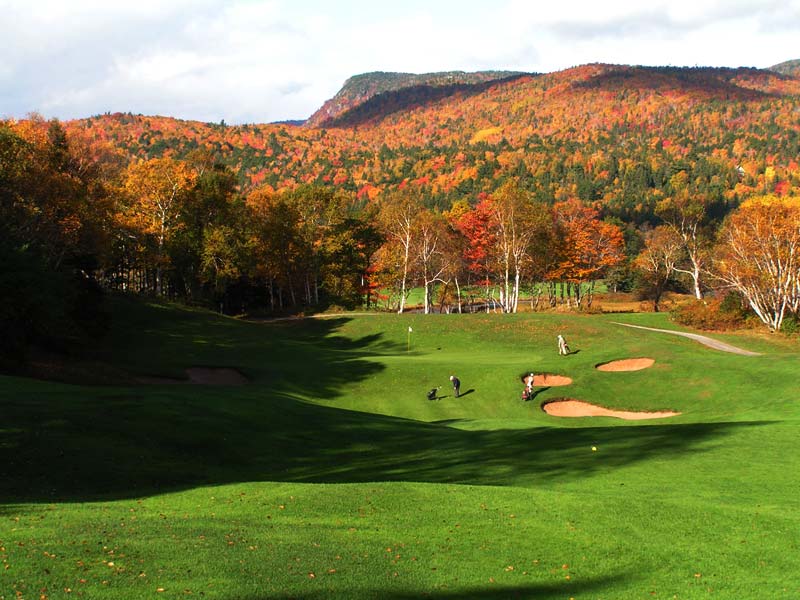
With the green benched into the hillside, drastically different recovery shots result depending on whether one is short or long with his tee ball.
Sixth hole, 540 yards, Mucklemouth Meg; Along with its short two shotters, another stand out collection of holes is the three shotters at Cape Breton. In fact, as compared with any other course with four par fives, the ones at Cape Breton may well constitute the finest set in the world. Not only is each one excellent in its own right but cumulatively, they are both diverse and distinctive from one another. As a show of how competitive the four par fives are with one another,many locals were surprised when the 6th hole was listed in George Peper’s The 500 World’s Greatest Golf Holes ahead of the other three. To their way of thinking, its fairway along the shoreline is flat, which is so uncharacteristic of golf at Cape Breton, and many place the other three par fives ahead of it because of their unique topography. Still, the diagonal carry off the championship 6th tee, added in 1996 by Canadian golf architect Graham Cooke, is undeniably a thrilling white knuckler. During the mid-1990s, Cooke and his then-associate Steve Miller orchestrated a renovation of the Highlands Links that reversed years of neglect under a Parks Canada mandate that disallowed the trimming or cutting of trees. The renovation included the removal of several hundred trees, the reconstruction of all the bunkers, the addition of several new tees (including the aforementioned4th tee) and the installation of a continuous cart path. Prior to 1996, Highlands Links was strictly ‘walking only’ and though the paved paths are a scar upon the landscape, people who would otherwise not make the seven mile walk now get to enjoy the course.

The required 230 yard diagonal carry from the new championship 6th tee is daunting, especially into the prevailing wind. Thompson’s original tee is farther left and plays down the length of the 6th fairway.

The bunkers at Cape Breton play ‘bigger’ than their actual size, thanks to some clever mounding by Thompson.
Seventh hole, 570 yards, Killer crankie; As with the other Golden Age architects, Stanley Thompson believed in giving the player plenty of room off the tee. For instance, the 2nd hole enjoys an 80 yard wide corridor. In comparison, the 7th, whose corridor is only slightly greater than half that, seems tight, which leads to nervous, guided swings from the tee. However, after several rounds, the golfer comes to appreciate that he should swing out as the fairway widens at the landing area and that the slopes actually gather golf balls in toward the fairway, making the hole less intimidating to play than it appears. As with the 15th, technology has perhaps even helped this hole as downwind the golfer can reach the green in two shots by playing down the dangerous tree lined left side and getting a kick forward off of the back side of a hillock. Many critics consider this the finest three shotter in Canada, in part thanks to the steep back to front pitch and bowl contour of its green.
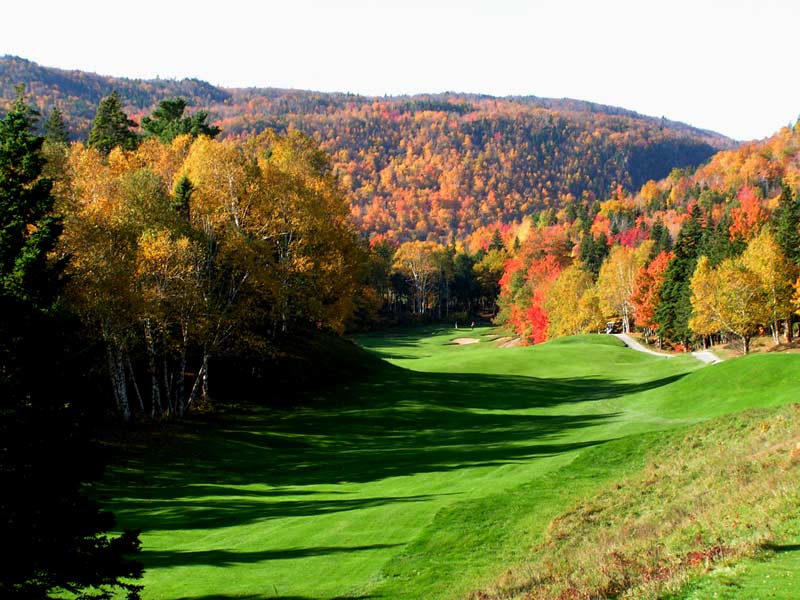
Thompson takes the golfer away from the shoreline and into the hills with the long, twisting three shot 7th.

Where else would a golfer rather find himself than at Cape Breton during peak autumnal colors in mid-October?
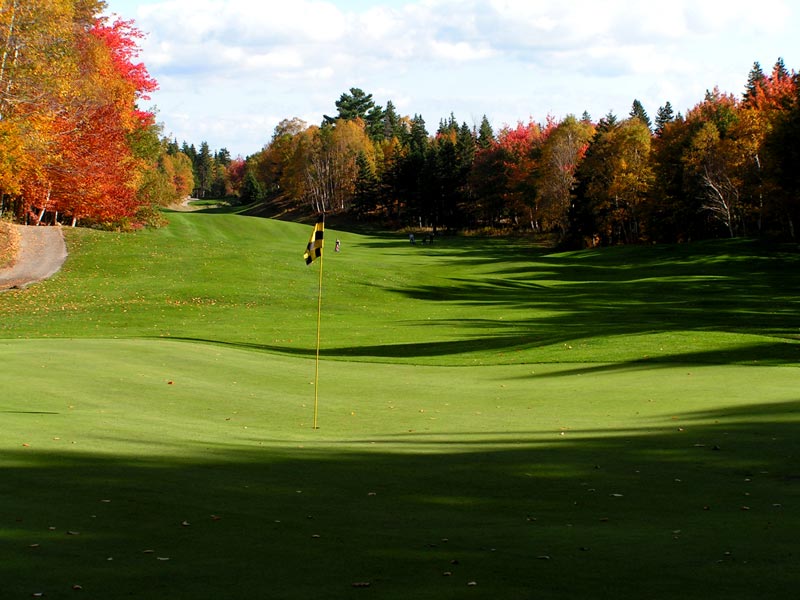
The view back from the green with the day’s hole location in the front bowl.
Eighth hole, 320 yards, Caber’s Toss; Not a hard hole by any means but a very fine one nonetheless, the ideal tee ball clears the crest of a hill 150 yards short of the green and bounds down toward the green. Indeed, with dry conditions and the wind at one’s back, the green can be driven. The subtle green is a fooler though as Thompson built it up its rear portion to the point where golfers become confused as to which way their putts break, convinced the ball wants to fall toward the back of the green with the natural downhill slope of the hole. Though many a good golfer may be close to the hole after one or two shots, plenty of fours are carded as a result.

A scant two holes ago the golfer was along the shoreline and now look at the view!
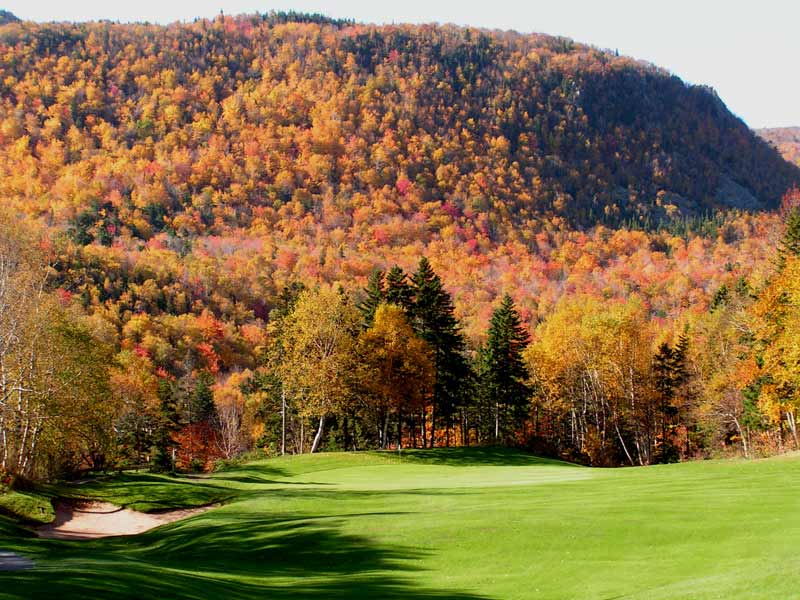
This view doesn’t capture how sharply the terrain tumbles down toward the 8th green…

…but this view does! Landing a bump and run approach shot 30 yards shy of the green is great fun.
Ninth hole, 335 yards, Corbie’s Nest; Thompson’s appreciation of the United Kingdom links is readily apparent with this interesting adaptation of the Alps Hole. In this version, the green placement on this dogleg right is such that the flag is blind from the right side of the fairway (the shorterroute to the green) and is readily visible from the left side of the fairway (though the shot is likely to be a club longer).

The ideal tee ball finds the plateau on the hillside on the outside of the dogleg right…
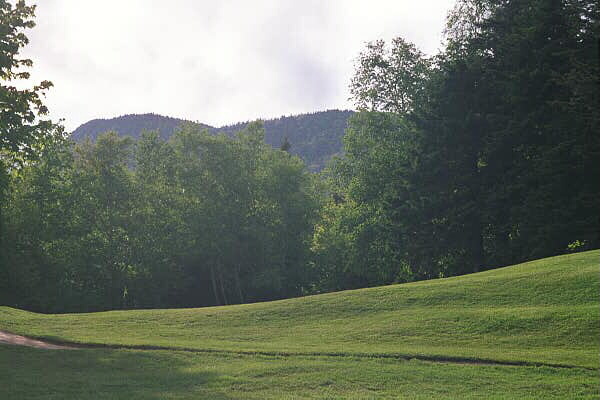
…with a view of the 9th flag being the golfer’s reward.
Tenth and 12th holes, 145 and 240 yards, Cuddy’s Lugs and Cleugh,respectively; Golf course architecture at the highest level is about variety and Thompson was a master (some say the master) at building variety into his one shot holes. Be it the 4th and 15th at Jasper Park or the 10th and 8th at Banff or the 14th and 16th at Capilano or the 10th and 12th here, there is often a nine club difference found within the set of his one shotters.
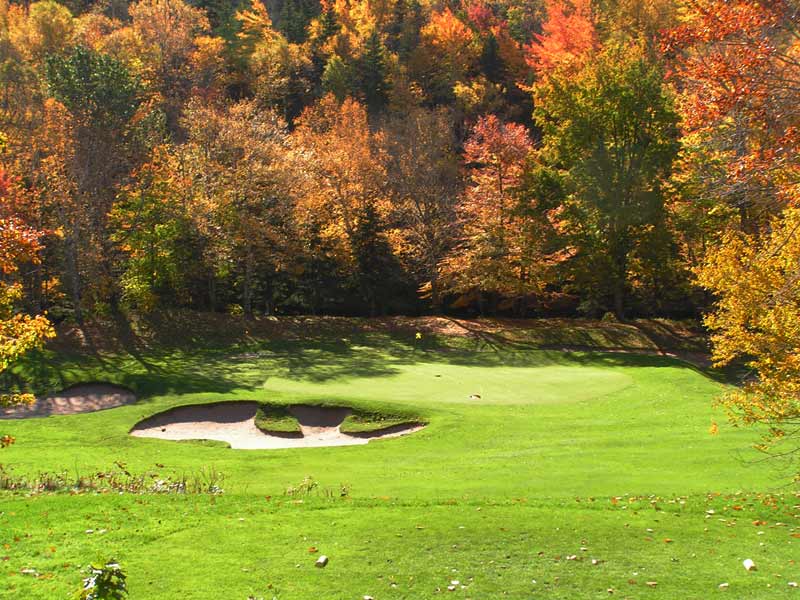
A pitch down the hill suffices at the 10th whereas…

…the long 12th often requires a wood and is level from tee to green along the stream.
Thirteenth hole, 435 yards, Laird; A wonderful tee to green study in sidehill architecture, which is something that Thompson also excelled at Capilano Golf and Country Club, the 13thends with the only non-Thompson green on the course. Thompson’s original punchbowl green drained poorly and collected ice during the long Cape Breton winters so it was replaced in the late 1960s with a raised, flatter green. Still, on the whole, the greens at Highlands Links are full of character and variety though few people focus on their merits given the course’s setting.
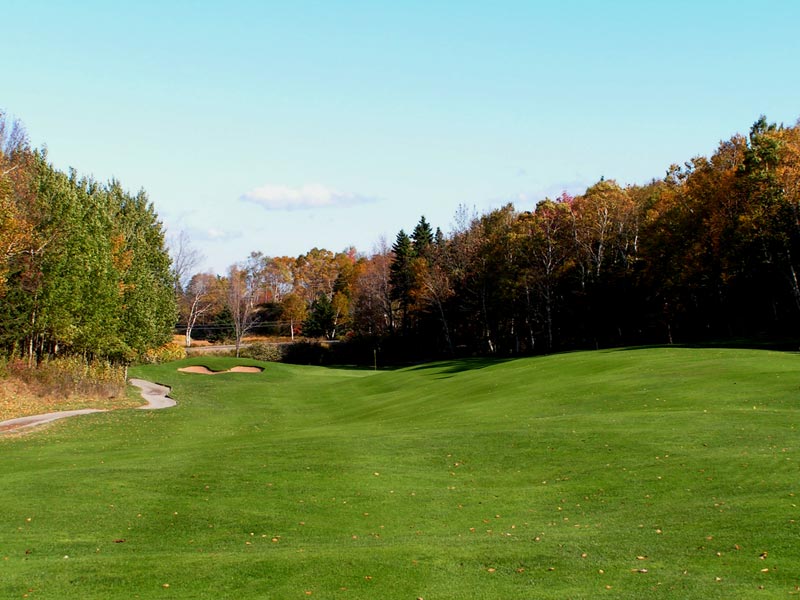
Thompson incorporated the dominate landform seen above into both the tee ball and…
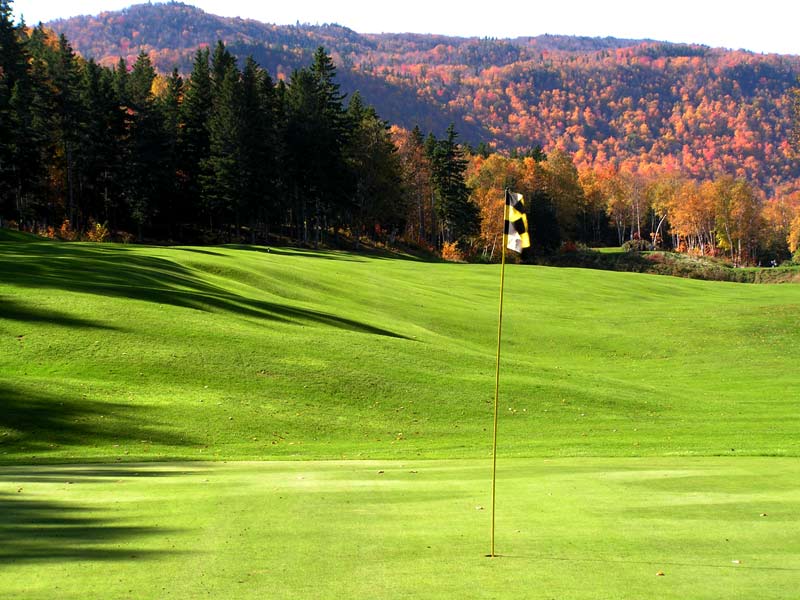
…the approach where the hump can be used to feed one’s approach onto the putting surface.
Fourteenth hole,400 yards, Haugh; Perhaps the most under appreciated hole on the course, the 14th is bunkerless and highlights one of Cape Breton’s most appealing attributes: its rumpled, crumpled topography.
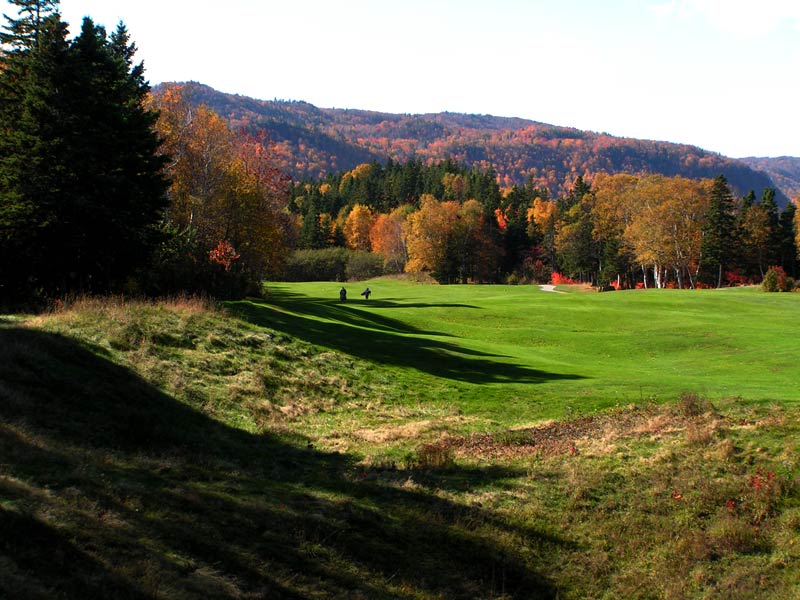
The view from the back tee at the 14th.
Fifteenth hole, 540 yards, Tattie Bogle; As alluded to in the 7th hole description, this hole downwind offers a thrilling chance to get home in two. To do so, the golfer must flirt with the forest and the shoulder of a hillock on the left but if he can carry the ball 260 yards, his tee ball will catch the back slope of the hillock and be propelled within 220 yards of the green. In addition, he is likely to draw a level stance. The actual playing of the 15this every bit as spectacular as the view of Whale Island in the distance.
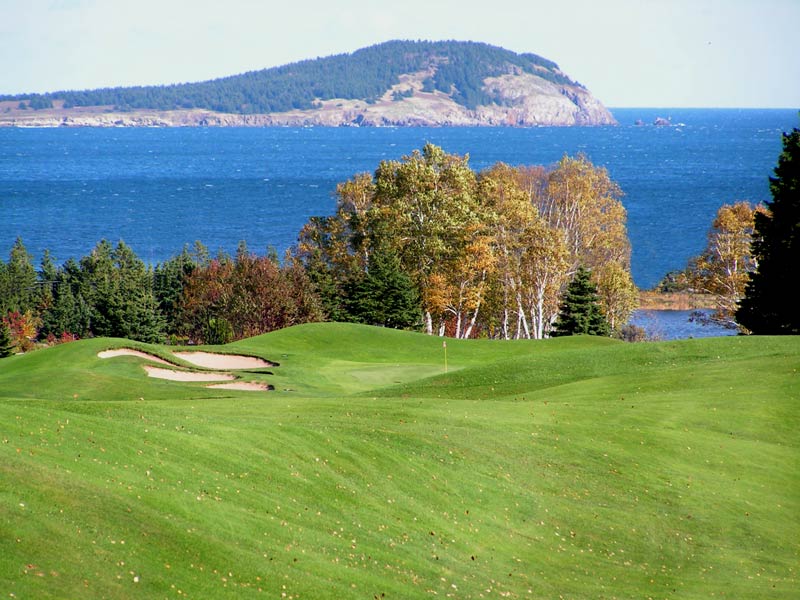
The bold play off the 15th tee is over the shoulder of the hill in order to…
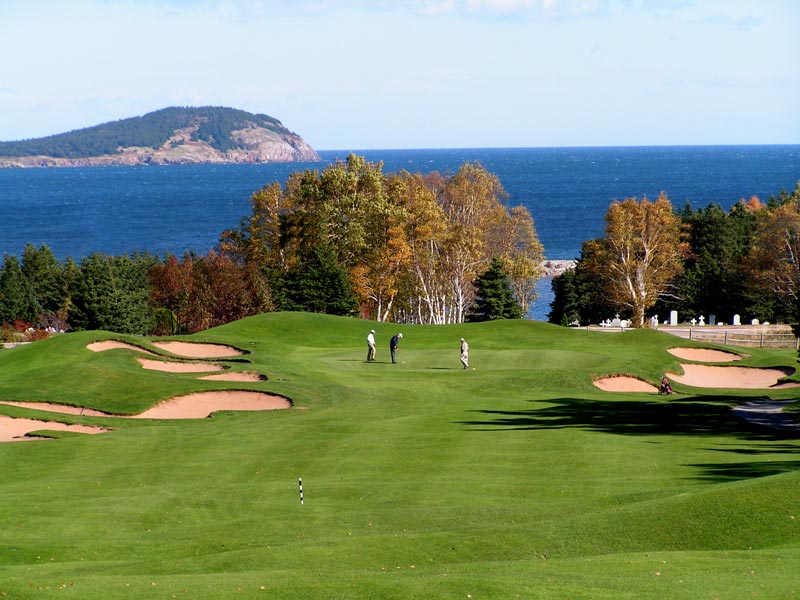
…bring the green in reach in two from the perfect angle.
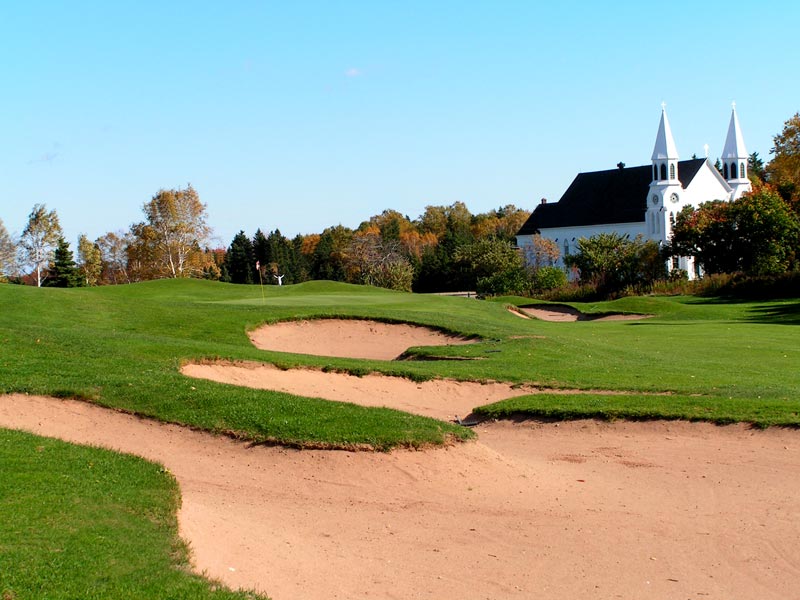
The bunkers that protrude left out from the green leave awkward length recovery shots and must be avoided.
Sixteenth hole, 460 yards, Sair Fecht; The last of the bunkerless holes, Thompson does little in guiding the golfer as to how to play it. Some locals play down the left side as the chance for a level lie is enhanced. Others go down the right of this wide fairway as it shortens the hole but they are at the mercy of the humps and bumps that Thompson created down that side. If a twenty foot embankment located some fifty yards shy of the green can be carried, the golfer may find himself in fine shape to record a four. However, if the ball just fails to scale the embankment, the golfer will be left with a blind shot from an awkward stance. Canadian writer and architect Jeff Mingay is so taken by the merits of this hole that he contributed a detailed In My Opinion piece on it that can be accessed by clicking here.
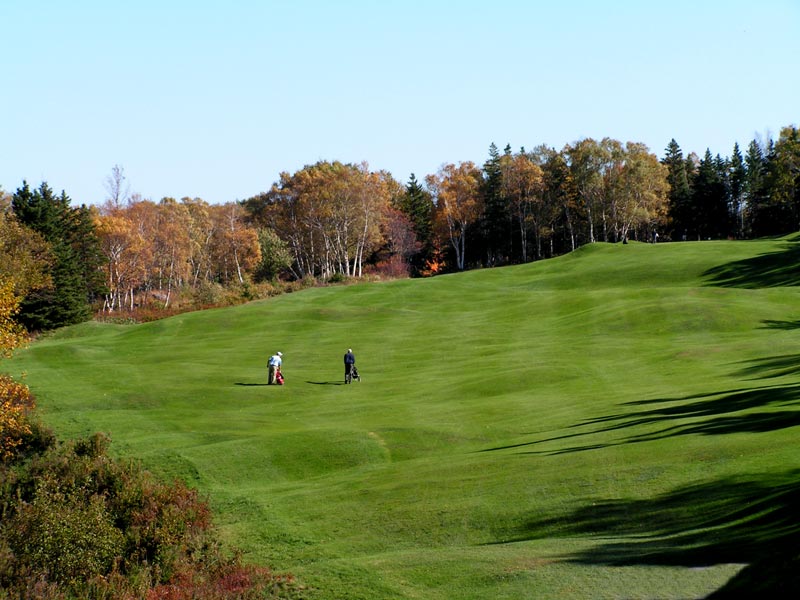
This view down the 16th fairway captures the outrageous topography that mother nature created and Thompson mimicked at Cape Breton.
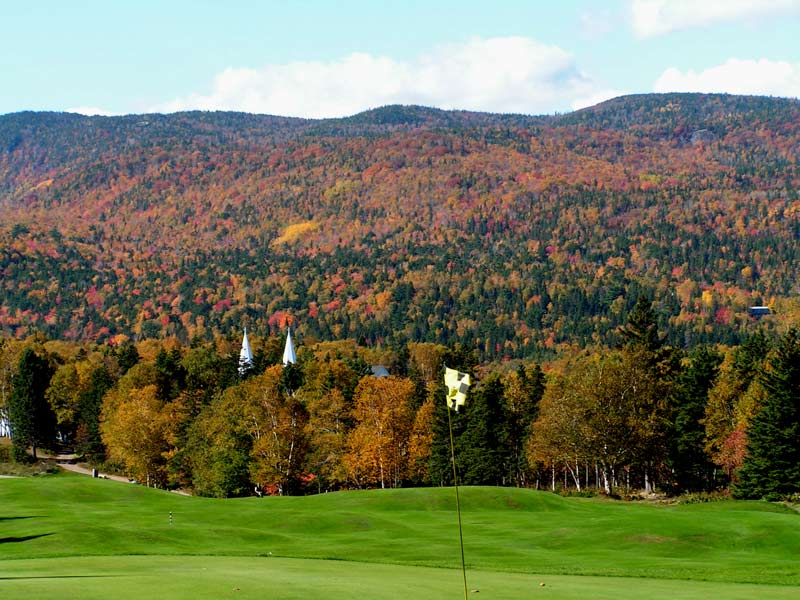
Turn one’s head one way on the 16th green and the view is of mountains and steeples.
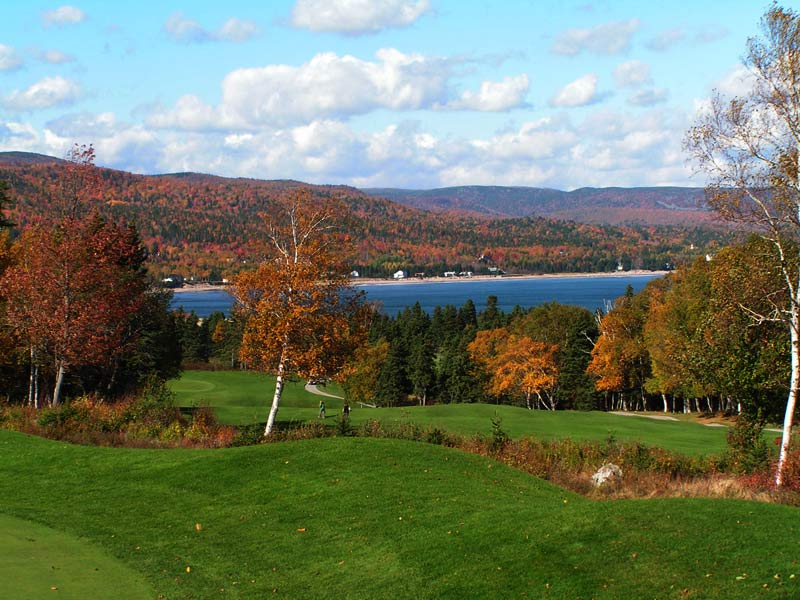
Turn it another and the view – almost inconceivably – becomes of the shoreline and water.
Seventeenth hole, 190 yards, Dowie Den; Tucked in its own natural amphitheatre, the 17th green has some of the best interior contours of any of the greens. In particular, the back right plateau might well possess the single finest hole location on the course with the regulars knowing how to bank the ball on to it.
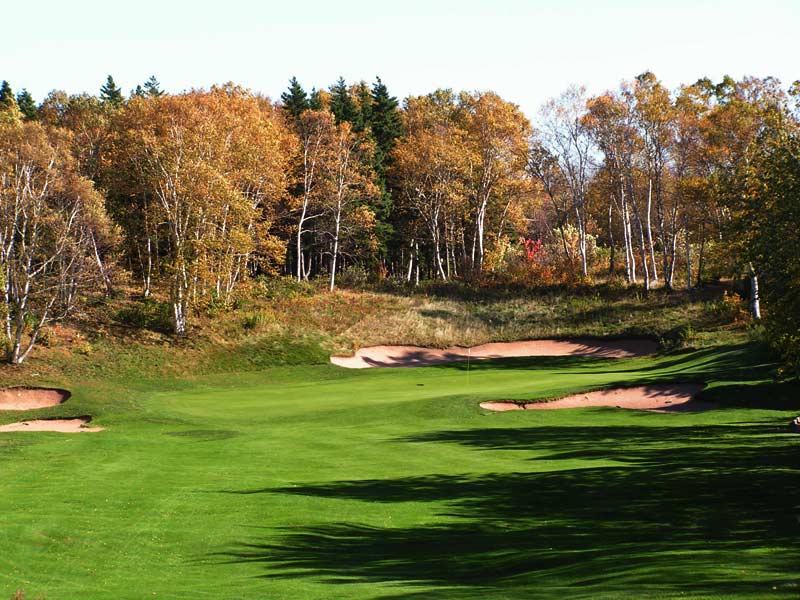
Other than the long 12th along the stream, all the one shotters at Cape Breton play downhill, including here at the attractive 17th.
Eighteenth hole, 410 yards, Hame Noo; Home now!! As always, Thompson followed the best land forms in routing the holes and in this case, the tee and green are on the high spots some 20-30 feet above the fairway, 390 yards apart. If the golfer carries the left fairway bunker, he is rewarded with the ideal angle into the rolling green, which is open across its left front.With the entrance road to the Keltic Lodge eight paces from the right edge of the green, it takes a brave man to chase after the right hole locations.
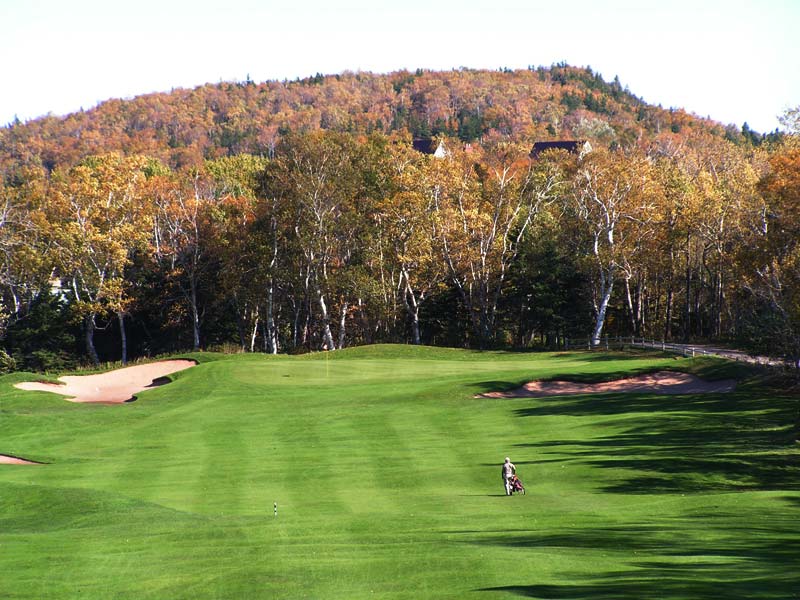
With the road and the large green side bunker on the right, the golfer wants to place his tee ball down the left of the fairway, past the well placed left fairway bunker.

The wildly undulating green makes for tough putts to win one’s match.
Among Thompson’s Famous Five (Banff, Capilano, Jasper Park, St. George’s, and here), Highlands Links is perhaps the least known as it stands alone as a true outpost in world golf. Yet, it is far and away easier to reach today then when Thompson and Cornish worked on the course. For instance, from Boston, Massachusetts, a two hour flight to Halifax followed by a one hour flight to Sydney puts the golfer onto Cape Breton Island. From there,a two hour drive north along the spectacular coastal Cabot Trail places the golfer at the course.
Players are always looking for a fresh experience, and it doesn’t get any fresher and more invigorating than on the northeastern tip of Nova Scotia. Because it is such a standalone experience reminding the golfer of no other course in the world, it is a journey that every golfer should make.

Located on the same peninsula as the golf course, the majestic Keltic Lodge is nine hundred yards from the 1st tee.
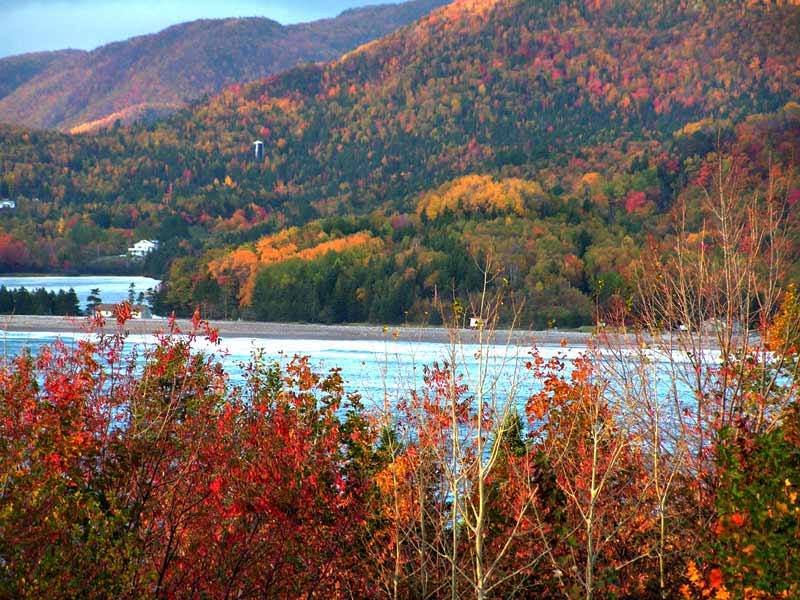
No wonder golfers head here in the fall. This photograph was taken on the walk from a cabin to the Keltic Lodge for breakfast one mid-October morning.
The End






